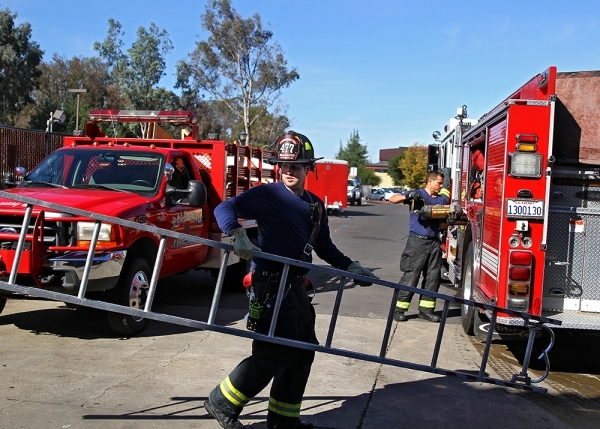After five years of tense talks, Palo Alto and Stanford University have reached an agreement on a new fire-protection contract, one that will ensure that the city's Fire Department will continue to serve the university until 2023.
The agreement, which the parties announced Thursday afternoon, effectively settles a dispute that goes back to 2012, when Stanford decided to shut down Station 7, which formerly served the SLAC National Accelerator Laboratory. The change sparked a prolonged disagreement between the parties over how much Stanford should now be paying to the city.
Palo Alto has been providing fire services to Stanford since 1976, when their respective fire departments merged. The 50-year agreement was amended four times, in 1981, 2006, 2016 and 2017. It gives both parties the option of terminating the arrangement.
The partnership almost ruptured in 2013, when Stanford notified the city that it was looking to terminate the agreement within a year. The university solicited bids from other providers but did not receive any. Meanwhile, Palo Alto continued to provide fire services to Stanford.
The new agreement ensures that, barring another termination attempt, the partnership will continue for at least five years. It will, however, including new terms when it comes to deployment levels and cost allocations.
City Manager James Keene stressed in a statement Thursday that both sides will benefit from the continued partnership.
"Stanford wants to receive and the City wants to deliver the highest quality and cost-effective emergency response services," Keene said. "Palo Alto residents will benefit from the economies of scale associated with the resources needed to serve Stanford that will be available community-wide."
In addition to establishing the new terms for fire protection, the two sides also agreed to settle the dispute over Stanford's overpayment to the city between 2012 and 2016 in the wake of the closure of Station 7. The settlement calls for the city to pay Stanford $5.5 million by July 1, 2019, which amounts to about 15 percent of the billings during that time period.
According to the Thursday announcement, Palo Alto and Stanford officials have been discussing the new deployment models since 2016. Under the agreement, the Stanford fire station (known as Station 6) will have a staff of six, enough to staff a fire engine, a rapid-response vehicle and a fire truck. The Palo Alto fire chief will have sole operational authority for deploying firefighters at the station.
The city will be required to provide response times in Stanford that are consistent with those in Palo Alto. This means meeting a target response time of eight minutes or less in an urban area; 15 minutes or less within a non-residential but high pedestrian traffic area; and 20 minutes within a remote open-space area 90 percent of the time.
The city and Stanford will also work together to design and institute a "fire alarm reduction program" on the campus to reduce false alarms. Under the new terms, the city will no longer respond to "supervisory or troubled alarms," which pertain to problems with the fire alarm system. Those calls would be forwarded to the Stanford Fire Marshal's Office.
In a statement, Fire Chief Eric Nickel praised the new agreement, as well as its new deployment model, which he noted was recently highlighted by external evaluations during the department's successful accreditation process.
"This agreement ensures long-term stability in the delivery of medical and fire/rescue services and the innovative deployment model will meet community expectations," Nickel said.
Jean McCown, Stanford's associate vice president, also lauded the agreement, which she noted will preserve a partnership that has been in effect for more than 40 years.
"We are very pleased we were able to come to an agreement and extend this important relationship into the future," she said.
The City Council is expected to approve the new agreement and the settlement with Stanford this Monday.



Comments
Registered user
College Terrace
on Aug 17, 2018 at 10:45 am
Registered user
on Aug 17, 2018 at 10:45 am
Thanks Jean and Jim Keene team.
We now sleep well because we know we are in good hands
Registered user
Barron Park
on Aug 17, 2018 at 10:54 am
Registered user
on Aug 17, 2018 at 10:54 am
> In a statement, Fire Chief Erin Nickel ...
Gee Gennady, unless there's another story you want to tell, I'm pretty sure it's still Fire Chief Eric Nickel, not Erin.
Web Link
Old Palo Alto
on Aug 17, 2018 at 12:05 pm
on Aug 17, 2018 at 12:05 pm
No where in this article does it state how much per year the city is charging Stanford for fire protection? Also, who is going to pay for Station 6 maintenance and Repair costs and the maintenance and replacement cost of the fire trucks staffed at Station 6?
another community
on Aug 17, 2018 at 9:59 pm
on Aug 17, 2018 at 9:59 pm
That’s because it’s significantly less than what Stanford paid in the past. The “economy of scale” has resulted in the City of Palo Alto cutting positions and reducing response capabilities. The deployment model was lauded by the equivalent of the Better Business Bureau, not an established public safety or firefighting body. Public safety budgets have taken a back seat to bike lanes and library’s and they’re selling it like an improvement. Good luck, just hope you’re in the 90% not the 10% who don’t receive timely service.